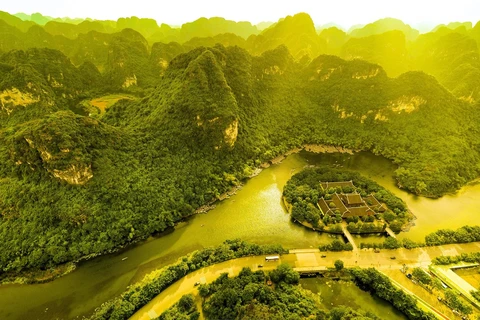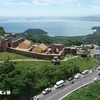Ninh Binh (VNA) – The northern province of Ninh Binh was recently listed among the top five most underrated travel destinations throughout Southeast Asia by the British magazine Time Out.
According to the magazine, popular destinations in Vietnam include the capital Hanoi, the ancient town of Hoi An, Ho Chi Minh City, and Sa Pa - a northern mountainous resort in Lao Cai.
However, it says visitors should not overlook Ninh Binh, home to the country's first capital Hoa Lu and the Trang An Scenic Landscape Complex - a modern-day UNESCO World Heritage Site.
"Defined by towering limestone karsts, tranquil rivers and mystical historical and religious sites, Ninh Binh is the perfect destination for nature lovers and adventure travellers keen to see another side of Vietnam, off the beaten path," says Time Out.
Just 100km from Hanoi, Ninh Binh is a suitable for visitors who do not have much time but still want to discover nature.
The land in Ninh Binh is beautiful year-round, but spring and summer are the best time to visit.
There are many choices for visitors in Ninh Binh, from historical sites like the ancient royal capital of Hoa Lu, Bich Dong Pagoda and Phat Diem stone church to wildlife destinations such as Thung Nham bird park, Cuc Phuong National Park, Van Long Wetland Nature Reserve and Trang An eco-tourism site.
Hoa Lu, the royal capital of Vietnam from 968 to 1010 under three dynasties – Dinh, Early Le and Early Ly, is one of the four core zones of the Trang An Scenic Landscape Complex.
Surrounded by steep limestone mountains and the Hoang Long river that create strong natural barriers, Hoa Lu also has great military value.
The ancient capital covered an area of 300ha, comprising the Inner, Outer and South Citadels, encircled by defensive earthen walls.
The ancient capital covered an area of 300ha, comprising the Inner, Outer and South Citadels, encircled by defensive earthen walls.
The Outer Citadel, about 140ha wide, is located in Yen Thanh village, Truong Yen commune. It is the main part of Hoa Lu, housing King Dinh Tien Hoang's temple and King Le Dai Hanh's temple. The two temples are about 500m apart.
The temple dedicated to King Dinh Tien Hoang still keeps two royal stone beds, recognised as national treasures.
 Tam Coc-Bich Dong tourism site in Ninh Hai commune, Hoa Lu district in the festival season (Photo: VNA)
Tam Coc-Bich Dong tourism site in Ninh Hai commune, Hoa Lu district in the festival season (Photo: VNA) From Hoa Lu, visitors can take a boat along the Ngo Dong river to discover the Tam Coc- Bich Dong scenic site. Tam Coc is said to be one of Vietnam's most beautiful cave complexes, and the site has been nicknamed an inland Ha Long Bay.
"Tam Coc" or "three caves" in Vietnamese, includes Ca, Hai and Ba, created by the river current running through karst mountains.
Ca Cave measures 127m in length with an entrance up to 20m in width. It is cool and humid inside the cave, which has a lot of stalagmites.
Hai Cave, located nearly 1km from Ca cave, runs 60m long. Ba Cave is near Hai Cave and runs 50m long. Its roof is lower than the first two caves.
The river cruise will take about two hours. Rice fields run from the end of the first cave to the second. At the end of May and early June, when the rice ripens, the scenery is more brilliant, with the yellow rice emerging from the green background of mountains, rivers and plants.
About 2 km from Tam Coc wharf is the Bich Dong Pagoda, hidden at the foot of limestone mountains. Bich Dong means "Emerald Green Grotto". The pagoda is so named because green trees surrounded it, and the scenery was really peaceful.
Bich Dong Pagoda was first built in 1428 under the reign of Ly Thai To on the Truong Yen limestone mountain range, Hoa Lu district. In 1705, two Buddhist monks, Tri Kien and Tri The, came here and discovered this cave with a pagoda hidden by dense and strong vines and plants.
Then they rebuilt it with a 3-layers pagoda - Ha Pagoda (Lower Pagoda), Trung Pagoda (Middle Pagoda) and Thuong Pagoda (Upper Pagoda). These three pagodas are built in ascending order. Reaching them requires climbing some step stairs.
Visitors should not miss Mua cave when visiting Tam Coc – Bich Dong. Mua cave is not impressive, but panoramic views from the peak above. Tourists to this place often try to reach the mountain's peak from where it could bring them to one of the most iconic views in Vietnam - a panoramic view of scenic limestone mountain ranges and paddy fields.
Another must-see destination is Van Long Wetland Nature Reserve, famous for appearing in the blockbuster film Kong: Skull Island. The site has retained its pristine tranquillity with clouds hovering above soaring limestone pinnacles.
Located in the north of the Gia Vien district, the wetland reserve, dotted with spectacular islands and caves, was created by a 30km flood-prevention dyke hugging the left bank of Da River. It is nicknamed 'No Wave Bay', with mirror-like tranquil water.
Van Long also holds two national records, one for the biggest group of Delacour's langurs, a critically endangered species at home and abroad, and the other as the "largest picture of nature".
Meanwhile, Trang An Landscape Complex is a spectacular landscape of limestone karst peaks permeated with valleys, many partly submerged and surrounded by steep, almost vertical cliffs./.























